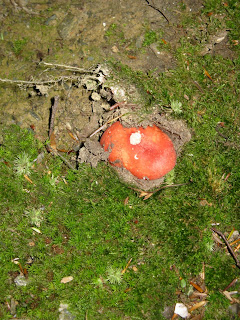 This might be an orange cort mushroom (Cortinarius spp.),
This might be an orange cort mushroom (Cortinarius spp.),a highly toxic and potentially fatal specimen.
A friend of mine has promised to take me mushrooming. This is an adventurous way to forage for local foods, but it can be dangerous and even deadly if you don't know what you are doing. I would never try this on my own, but I feel confident in my friend's knowledge — it has been a skill/hobby/tradition that has been passed down through his family and taught with care.
As well as being deadly, it is also competitive “sport.” There are a few known areas (well, known to seasoned forest foragers) and only certain times of the year (mainly late summer and early fall in New England) that these highly prized edible mushrooms can be found. I have not gone yet, but my friend has made me swear to secrecy as to the location of the mushrooms we will soon harvest. He also told me we have to go very early in the morning because those that know about them will take them all and leave none for the late risers.
This upcoming adventure has been on my mind, and I have been more aware of the fungi in the forest when my dog and I take our hikes. I am very curious to know about all the mushrooms I see. I do know that many are very poisonous, and I would never pick one unless I knew for sure that it was safe.
I have been trying to prepare myself mentally for my upcoming excursion. Last night, on my after-work hike with my dog Lily and my friend Heather (not my mushrooming friend), I brought my camera along and took some pictures. I'd like to share some of my fungi finds.

 The mushrooms in the two photos above, I think, are orange cort
The mushrooms in the two photos above, I think, are orange cortmushrooms. I flipped through the mushroom chapter of
The North American Guide to Common Poisonous Plants and Mushrooms
and found a photo and this description: Fleshy, often colorful mushrooms
with rounded cap, young specimens with cobweb-like partial veil
extending from edge of cap to stem. Some species highly toxic;
potentially fatal, causing kidney failure. Symptoms may be delayed
2 to 17 days. For safety, do not eat any Cortinarius species.


 Species unknown to me. It was beautiful and was growing out of a fallen and rotted tree. The colors and shape of this mushroom remind me of sea coral.
Species unknown to me. It was beautiful and was growing out of a fallen and rotted tree. The colors and shape of this mushroom remind me of sea coral. This species of mushroom may be Russula pulchra. I found
This species of mushroom may be Russula pulchra. I founda similar mushroom on a Web site that identified it as that
and said it was poisonous. I could be wrong — there are
hundreds, maybe even thousands of mushroom species,
and many look very similar to one another. While one could
kill you, the other might make a gourmet meal. Be sure to
check with an expert before eating any species of mushroom
whose identity you are not absolutely positive of!

3 comments:
Those may be poisonous, but what beauties! They beg to have some macro photography shots of them...
I've always wanted to do it! There are so many pretty fungi about the place.
I agree about the photography — I so wish I had a better camera! In a few weeks I am going camping on Knight Island (a very remote campground on Lake Champlain close to the Canadian border). Every year I see all sorts of crazy-looking wild mushrooms and fungi. I plan to take photos of those too. It'd be fun to try to identify them and/or have the readers take a stab at it.
Post a Comment